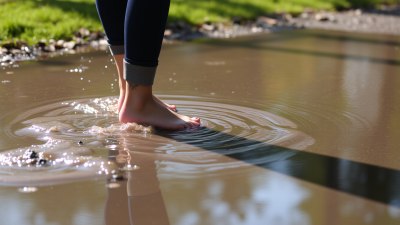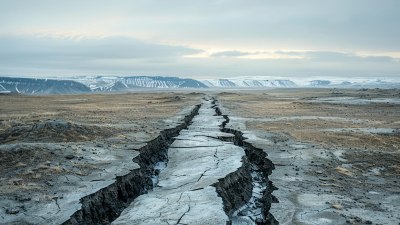Why That Puddle Looked Shallow Until It Ruined Your Entire Day
Explore the hidden dangers of shallow puddles and how they can unexpectedly disrupt your day and safety.

On a seemingly ordinary day, you spot a puddle shimmering under the sunlight. It looks shallow, harmless even. But as you step into it, what seemed like a trivial obstacle quickly turns into a day-ruining mishap. This situation is all too common, yet often overlooked. How can a shallow puddle cause so much trouble? Let's dive into the science, psychology, and real-life implications that make these small water bodies far more dangerous than they appear.
The Deceptive Nature of Puddles
Puddles might appear trivial and inconsequential, but there are multiple factors at play that make their true depth and danger nearly impossible to gauge at first glance. The primary culprit for this deception is the refraction of light in water. When light passes from air into water, it bends, creating an optical illusion that distorts the puddle’s actual depth.
This bending of light makes water seem shallower because our eyes naturally interpret shallower depths when light bends away from our line of sight. Even a puddle that is a few centimeters deep might appear almost dry, leading you to underestimate the risk of stepping into it.
How Lighting and Surroundings Influence Perception
Lighting, angle of view, and surrounding objects all contribute to this misperception. For instance, if the sun is shining at a low angle, it can reflect off the water surface, making the puddle look like a shiny patch rather than a deep pool. Also, if the ground under the puddle is dark or covered with leaves, the water might camouflage the actual depth, making it appear as a flat wet surface.
Moreover, the surroundings often provide false cues. Pavement cracks, dips, and uneven surfaces beneath puddles can create pockets of deeper water masked by the surrounding terrain. These subtle features are invisible to the naked eye under a layer of water, making it easy to misjudge the depth.
The Physics Behind Puddle Depth and Impact
While the optical illusions contribute heavily to misjudgment, there is a physical aspect to consider. The force and effect of stepping into what appears to be a shallow puddle can be surprisingly significant due to how water behaves under pressure.
Water is incompressible, meaning it cannot be squashed into a smaller volume. When your foot pushes down into the puddle, the water has nowhere to go but sideways and downward. If the puddle covers a depression or a soft patch underneath, your foot may sink unexpectedly, causing slips or falls.
In many urban environments, puddles collect over uneven surfaces that might be slippery or hidden holes. When your foot sinks into these depths, you lose stability, leading to sudden slips or twists of the ankle, which could easily ruin your day with pain or injury.
The Psychological Effect of Underestimating Puddles
Psychology also plays a key role in why you might think a puddle is shallow until it causes problems. Humans rely heavily on visual cues to assess risks, and when those cues fail due to optical illusions, we often act with unwarranted confidence. This leads to underestimation of potential hazards, an effect studied in cognitive psychology as part of risk perception.
When something looks safe based on past experience or visual certainty, you tend to pay less attention to it. This automatic decision-making, called heuristics, saves time but can backfire. Puddles, being common and seemingly insignificant, often bypass our safety checks, and that's when accidents happen.
Common Accidents Caused by Misjudged Puddles
The consequences of misjudging puddle depth vary widely. Some common incidents include slipping and falling, which can lead to bruises, sprains, or even fractures. Another frequent issue is getting footwear or electronics water-damaged when stepping into deeper puddles than expected.
Bicyclists and motorbike riders, in particular, are vulnerable to puddle-related accidents. A wheel striking a hidden hole beneath a puddle can cause loss of control or crashes. Drivers can also hydroplane on wet patches if conditions are right, further increasing risks during rainy weather.
Real-Life Stories of Puddles Gone Wrong
Consider Jane, who was hurrying to an important meeting on a rainy morning. She saw a puddle on the sidewalk, glanced over it, and stepped in confidently. Suddenly, her ankle twisted badly due to a hidden pothole covered by water. The injury led to weeks of pain and missed work. Jane's story is not unique; millions of people experience similar incidents annually, indicating a widespread hazard overlooked in urban landscapes.
In other cases, puddles have caused more severe outcomes, like vehicle damage or bike crashes. What seems like a shallow inconvenience can cause long-term disruptions in plans, finances, and health.
How To Safely Navigate Puddles
The key to avoiding puddle-related accidents is awareness and cautious behavior. Here are some practical tips:
- Observe Closely: Look for reflections, water color, and surrounding ground texture. Dark or murky water likely hides greater depth.
- Test Softly: Gently tap the area with a foot or stick to sense if the ground beneath is firm or soft before stepping fully.
- Use Alternative Routes: If possible, avoid stepping into puddles by walking around them or on higher ground.
- Wear Appropriate Footwear: Shoes with good grip and waterproof properties reduce slipping risk and keep feet dry.
- Mind Your Speed: Slow down when approaching puddles, especially in poor light or unfamiliar areas.
Urban Design and Puddle Prevention
Beyond personal caution, urban planners play a vital role in minimizing puddle hazards. Proper drainage systems can prevent water accumulation on walkways and roads, reducing puddle formation. Designing pavements with slight slopes and permeable surfaces allows water to flow and be absorbed quickly.
Regular maintenance and repair of cracks, potholes, and depressions are also crucial. When streets and sidewalks remain intact, the risk of sudden dips or holes hidden by puddles decreases, thereby reducing accidents.
The Science of Water Deposits and Evaporation
Puddles form when water collects in natural or artificial depressions. Evaporation causes them to shrink over time, but factors like temperature, humidity, and sunlight influence how quickly this happens. Shallow puddles evaporate faster, but if the ground remains saturated or shaded, puddles can persist for hours or days.
Understanding evaporation helps anticipate when puddles might become less hazardous. However, rain patterns and drainage variations often make this process unpredictable, emphasizing the need for caution whenever puddles are present.
Why Your Day Feels Ruined After a Puddle Incident
Stepping into too-deep water unexpectedly isn’t just an inconvenience; it triggers a cascade of disruptions. Firstly, wet shoes and clothes create discomfort, chilling your body and reducing focus. You might be forced to stop and dry off or change footwear, wasting time and energy.
Injuries, even minor ones, cause pain and might require medical attention or rest, disrupting daily schedules. For professionals or students, this could mean missed appointments or deadlines. Beyond physical impacts, such mishaps cause irritation and stress, negatively affecting your mood for the remainder of the day.
Technological Innovations to Detect Puddle Depth
Emerging technologies aim to reduce puddle-related accidents by improving detection and awareness. Smartphone apps now use cameras and AI to analyze water bodies and estimate depth before stepping. Wearable tech can provide alerts about slippery surfaces based on sensor data.
Smart city initiatives also deploy sensors embedded in sidewalks to monitor flooding or unsafe conditions in real time, sending alerts to pedestrians and local authorities. These innovations promise to make urban environments safer and reduce the frequency of puddle-related mishaps.
The Role of Climate Change in Puddle Formation
Climate change impacts rainfall patterns worldwide, leading to more frequent and intense storms in many areas. This results in increased surface water accumulation and longer-lasting puddles in urban spaces. Poor drainage further compounds the issue.
As a result, the risk of encountering deceptively deep puddles rises, underscoring the need for improved infrastructure and public awareness campaigns to adapt to changing environmental conditions.
Practical Psychological Tips for Risk Assessment
Improving your risk assessment skills can help avoid surprises when facing puddles or other everyday hazards. Here are some psychological strategies:
- Slow Down and Observe: Avoid rushing, as hurried decisions often lead to misjudgments.
- Question First Impressions: Remind yourself that appearances can be deceiving, especially with water.
- Learn from Experience: Reflect on past puddle incidents to identify warning signs you missed.
- Stay Mindful: Maintain focus on your surroundings, especially when weather conditions change.
Summary of Key Points About Puddle Risks
To recap, the deceptiveness of puddles arises from visual illusions caused by light refraction and camouflage. Physical risks stem from water behavior combined with hidden ground irregularities. Psychological factors lead us to underestimate these dangers, resulting in slips, falls, and other mishaps.
Preventing puddle-related incidents requires a mix of personal vigilance, improved footwear, urban planning, and emerging technology. Awareness of climate impacts and proactive safety habits also contribute to safer navigation of wet environments.
Ultimately, puddles are a reminder that even the most mundane features in our surroundings can present hidden hazards. Recognizing this helps us stay safer and more prepared for unexpected challenges on our daily routes.











